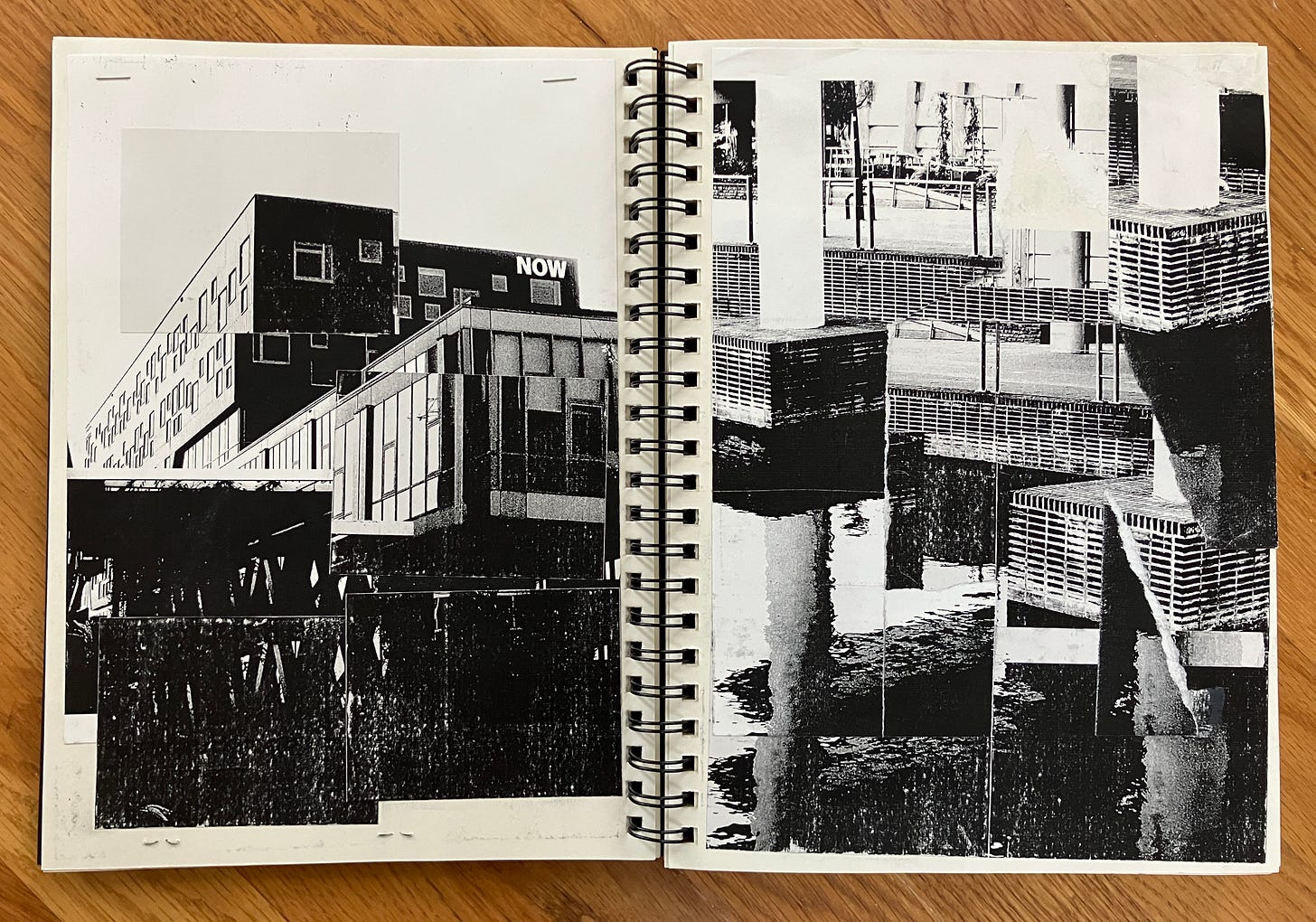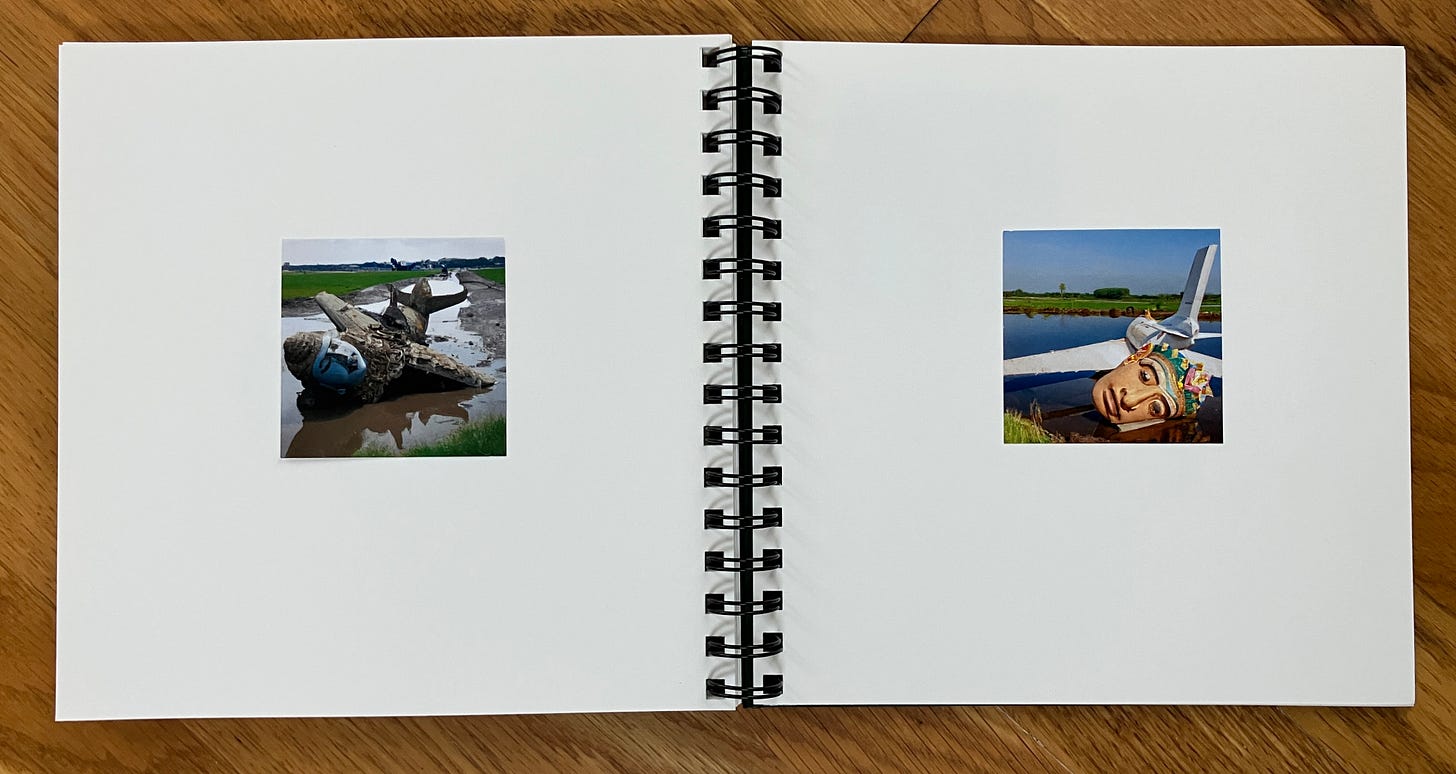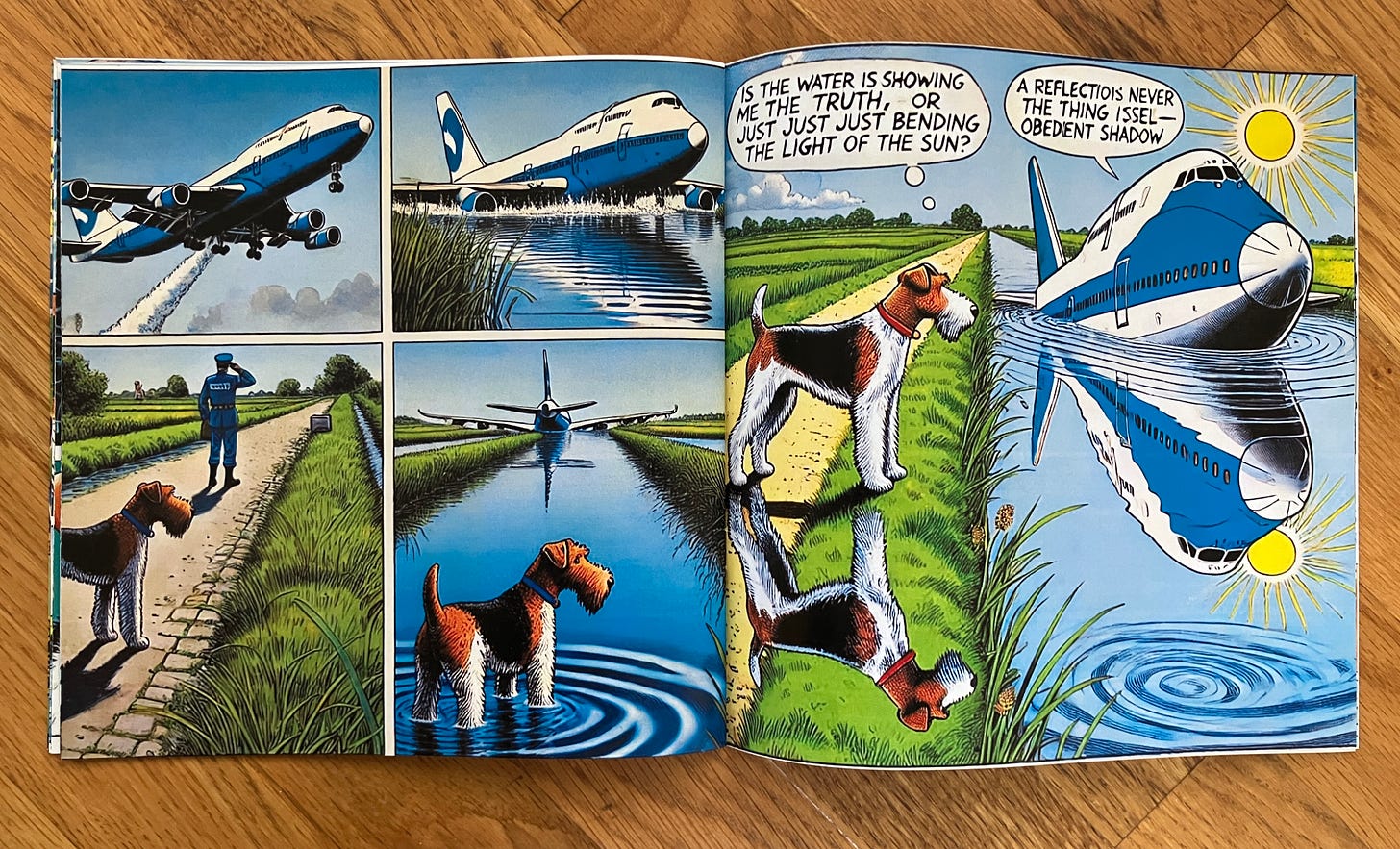
I had made my first stab at generating AI images on November 1, 2022 in the weeks after DALL·E became publicly available for general use. Images made on the platform were suddenly appearing all over social media. Everyone knew AI was around the corner, but the inflection was surprising nonetheless.
Finally, something new. Something new, finally. The new final something. The final new something.
At that time, I felt that the generated images seemed to consist of two portions, a foreground and background. The foreground portion often had a broken and unreal appearance, while backgrounds could conversely render in a hyper-real detail, just slightly blurred. So instead of asking to the AI to create “real” objects, I began to ask it to create sculptures, describing mediums such as sandstone, concrete, or clay. Next I placed the sculptures outside where their unreal appearance now presented as weathered and damaged, instead of merely unfinished.
I dabbled with sculptures placed on Polynesian seasides, in a pinewood forest, on the high plains drifter desert, in rocky quarry bottoms, atop various inland bread-basket grasslands. But I settled on a favorite landscape, the Dutch polder, that Batavian1 obscurity. Most (perhaps all) of the planet’s surface is now shaped by human occupancy; the polders of the Netherlands, drained tracks of land, often laying below sea level, are among the most engineered of human built landscapes. “God created the world, but the Dutch made their own country”2 is a phrase often quoted to describe the Netherlands, a country reclaimed from the sea, a process that accelerated in the 1600s just as the Dutch Republic also created the Dutch East India Company, the first modern corporation, and founded the Amsterdam Stock Exchange, the first modern securities market.
Some of the stickier mud of financial modernism emerged from that lowland’s submerged silt, the drained lakes and sea, a shallow underworld pumped dry and made muckily transversable.
My fascination with the polder landscape originates from a lifetime of American arrivals and departures at Amsterdam’s Schiphol airport, JFK-AMS, AMS-IAH. The airport is built on the Haarlemmermeer, a drained lake between the cities of Haarlem and Amsterdam. The name “Schiphol” is obscure and predates the invention of flight. Conflicting theories attribute it either to “Ship’s hole”, referencing the violent and dangerous ship-sinking storms in that portion of the lake. Another explanation names it not after “ship” but instead to “scheepshaal”, a ditch used to drag (or “schlep”) boats. Yet another etymology names it “schip hol” after a low-lying forest (the hol) cultivated for ship-building lumber. All three explanations each nicely suit the pre-history of an airport: ships and schlepping, vessels and cargo, flying and taxiing.
On a whim, I have once spent a night at a Schiphol hotel with the purpose of exploring the airport’s transit environs, en transit. I took a bus to the nearest town, Hoofddorp, and used an app on my phone to rent a bike. It was a typically cold and gray day. Bike paths allowed me to trace the perimeter of the airport’s vast territory; I felt a charge of the psychic geographical exploration described by Ian Sinclair in his descriptions of probing London’s orbital M25 highway with Bill Drummond in the late 1990s.3
Here it is, the invisible forcefields of globalism and capital, each road, canal, and runway spinning long and articulating gossamer threads. On that gray Sunday, village Hoofddorp felt deserted, and indeed much of it appeared to be an unoccupied and maybe abandoned office park. Just outside the village were farmhouses that could have been scenes from a gloomy Van Gogh “potato eater” pictures (before Paris, ante-absinthe), if it were not for the impossibly lumbering transit-industrial aircraft track-floating overhead: variously, Boeing 787, 737-800, 737-700, 777-300; Airbus A320, A319, A32neo, 303-300; Embraer 190, 175, 195; and rattle-trap cargo-outfitted 747s.
Dreamliners.
Perhaps the strongest impression of that day biking was the constant roar of those jet engines. The noise floated like a heavy, moist roof, as if the entire polder was a vast but finite room, like the interior of a climate-controlled covered dome stadium or the nave of a clammy Dutch-reform cathedral, iconoclasticly-stripped of every extraneous decoration and detail.
I was also jet lagged, tired and wired; when I chanced upon a vast garden-set4 of earthworks designed to blunt the engine roar. It was a place both more real and more fictional than other places I’d visited that day: the Begraafplaats Gan Hasjalom, Spottersplek Polderbaan, Algemene Begraafplaats Wilgenhof. It felt like the disturbingly specific location of a place in an anxious dream. I took some photos, I listened and looked and breathed; I returned the rented bike to a digital bike lock, boarded the bus back to Schiphol, checked into the hotel and I slept.
Some time after, I began to write that lived-dreamscape into DALL·E. I devised the sculpture garden into various sections. The oldest section, designed by a student of Joseph Mendes da Costa, was to be built in the 1920s to commemorate the Second Boer War.5 Dutch shipping companies, KPM (sea-craft) and KLM (air-craft) commissioned a second section, with sculptures portraying abstracted vessels. The garden continued with partially submerged bunkers built during the wartime occupation as Organisation Todt’s Atlantic Wall fortifications; a forgotten criminal-engineer arranged the bunkers frivolously surrounding the Boer War memorial. The garden was abandoned until the 1970s when an Italian Domus-funded experimental furniture designer built a series of humorous and functionless cast ceramic chairs and sofas in the polder and canals. The next section was built in the 1990s by an Indo-Balinese artist who fused the iconography of wayang golek with discarded airplane fuselages and wings. Finally, to celebrate the turn of the millennium, a controversial conceptual artist collective crash-landed an Airbus A310 into the polder, where it continues to sink into the giving and gone soft ground.









Satisfied with this sculpture garden, I printed the photographs at a print lab, as if they were vacation snapshots, and pasted my favorites into a small album. It felt real, and it is real. I took a trip, I took some photos, and I preserved the memory. And like a trip, I mostly forgot about it and did not return.
Leave only (digital) footprints, take only (imaginary) photographs.
November 2024 felt like another AI inflection point. It was creeping into seemingly every online application, popping up everywhere and all the time. It reminded me of of Clippy, Microsoft’s short-lived virtual assistant, but this time Clippy looks like they are here to stay.
I returned to DALL·E exactly 2 years after my first trip. I decided to stay in the polder, maybe see some more sculptures. But my garden was gone, and there was no going back. Since that earlier version, DALL·E was now delivering a smoother and more finely rendered style, both in the foreground and background. That smoothing of focus flattened the images and they no longer projected like the objects of dreams; the images presented as advertisements preceding the invention of product, and production. AI had developed into style, a genre, a fantasy-illustration genre somewhere in a pocket with illustration artists like Zdzisław Beksiński, Maxfield Parrish, or Thomas Kinkade. At it’s best, it reminded me of the puzzle montages of Tim Klein and Mel Andringa6; at it’s worst it brought to mind Beeple.
So I tried a new tact. I described in words my sculpture garden and let the AI iterate writing about the place, feeding in the original prompts. But instead of trying to portray it again, I asked DALL·E to write a “5 panel comic in the claire ligne style about a wired hair fox terrier solving a mysterious mystery in the polder and sculpture garden around Schiphol airport”. The AI has a great grasp on the fox terrier personality, and it understood, in this weirdly specific context, the garden perfectly. And so our detective dog explores the McGuffin mystery, bolting from panel to panel, seemingly oblivious of the people wandering around sometimes in the distance (somehow the drawings capture the spirit of the Charlie Brown TV specials, with the occasional adults reduced to a muffled and irrelevant background noise).
I love this comic. Maybe it’s not for everyone. Maybe it’s only for me. But it’s exactly the comic I wanted to read. It’s Snowy from Tin Tin, it’s Asta from the Thin Man, it’s Ian Sinclair and Bill Drummond on their London walkabouts, it’s JG Ballard’s Concrete Island, it’s Kafka’s Nature Theatre of Oklahoma, it’s Kuifje in Amerika, it’s Krazy Kat tripping in the trippy Zap #4 Victor Moscoso chapter, it’s derivative Moebius in a Polish bootleg Metal Hurlant, it’s Theo van den Boogaard and Joost Swarte in the publications of Oog & Blik, circa that reverse-penultimate year, 1985.
The next morning I fired up DALL·E for a sequel. No dice. Predictably, we were stuck in the polder for a while, but I wanted a new scene. We went to Hong Kong, Cairo, Wyoming. The drawings had lost their mystery, their charm; they looked like AI, they did not look like anything at all.
A message at the bottom of the screen suggested restarting for the next version.
Update, reboot.
Change the clock, fix your shoes.
But don’t look back, there’s nothing to see there but the reflections.
Batavia: the Latin name given by Roman map-makers to the present-day Netherlands; later used by Dutch colonials as the name for cities of present-day Jakarta and also a town in upstate New York.
The phrase’s obscure origins likely dates to Scottish visitors describing the region.
SINCLAIR, Ian. London Orbital: A Walk around the M25. Granta, 2002
See Land Art Park Buitenschot, near Polderbaan.
See Monument Generaal de Wet, Nationaal Park De Hoge Veluwe.
Two contemporary collage-artists using puzzles as their medium; often puzzle publishers reuse jigsaw patterns, allowing creative reconstructions for various sets. The pattern making techniques of AI often produce similar results, albeit on a exponentially vaster scale of material, and pattern.







